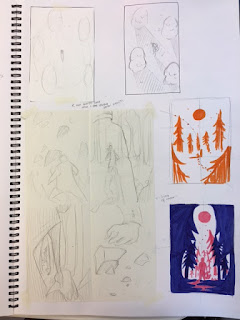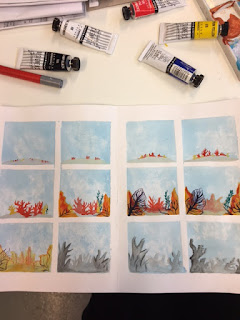End of Module Student Evaluation
BA(hons)
Illustration
Module
Code: Visual Skills OUIL405 Visual Narratives
Name:
Diandra Wardhana
Student
ID: dw262485
Please identify where the evidence for each of the learning outcomes
is within your submission and how well you feel you have met the learning
outcomes. Please also grade yourself in relation to the learning outcomes using
terms:
> poor, satisfactory, good,
very good, excellent (Note- This is
so that the team have an understanding of how well you feel you have done. It
is not an indication of the actual grade you may receive)
Learning Outcome
|
Evidenced
where?
Blog,
Sketchbook, Roughs Final Illustrations, development sheets etc. (No more than 75 words)
|
Your
grade
Using words:
> poor,
satisfactory, good, very good, excellent
|
4A6
Demonstrate a range of approaches to research in the collection,
development and communication of source material.
|
Blog, Sketchbooks
|
Good
|
4B5
Explore individual responses to creative opportunities, source
material and visual research appropriate to set briefs and identified
problems.
|
Blog,
Sketchbooks
|
Good
|
4C6
Select and investigate appropriate practical approaches to the
investigation of visual development and communication of source material in
response to a brief.
|
Blog, Sketchbooks, Roughs/Test pieces
|
Good
|
4C7
Explore appropriate processes and techniques in the visual development
of ideas relating to narrative, sequence and content.
|
Blog, Sketchbooks, Prototypes, Final
Illustrations
|
Good
|
4D5
Demonstrate an effective use of
appropriate methods of recording, documenting and evaluating individual
progress.
|
Blog, Sketchbooks
|
Good
|
Evaluation (See
guidance below for more information)
You are required to write a 500 word
evaluation of this module.
I was pleased that I had completed
this module. It ended with a sense of accomplishment and that the research
and development seemed worthwhile. I would say that I am quite satisfied with
the outcome, though I particularly thought that the research, development and
process was rewarding as I got to explore a subject matter that I really enjoyed.
Reflecting back to my research, I
had wished that I could have looked more into the subject. I have gathered
sufficient information though I felt that I didn’t use the most out of my
research. Perhaps I could have spent more time exploring sea life in more
depth. However, I had invested most of my time and energy exploring materials
and approaches to visually narrate the intent of my project. Throughout the
development week(s), I discovered that I was interested in shapes and
colours, as well as paper cutting. I felt that it was rather surprising since
I often use watercolours and I tend to focus lot in line quality. I thought
that it was a rather refreshing change. I had looked into several creative
practitioners and it was helpful in terms of kick starting my development and
exploration. I was particularly inspired by Jon McNaught’s practice and I
felt that his approach of using short, simple sequences and moments to
capture a story was charming.
I honestly felt that I had
difficulties focusing during this module. Perhaps it was because the amount
of independence and I sometimes would get confused with what I am going with
this brief. The issue was that I had been too fixated and spent too long
contemplating on the problem more than I was finding solutions. For instance
when it came to creating prototypes and mockups I felt quite lost. The ideas
I had were everywhere and everything seemed disconnected. However, after
speaking to other people it slightly cleared out my confusion. Though it was
when I took the time to pause and evaluate my work to see where I am lacking
or needing to further develop. From there, I actually scrapped my initial
ideas, referred back to my research and decided to focus on a particular
aspect that I would like to further explore. That phase of not being able to jump
the hurdle was horrible and mentally draining.
Moreover I thought that I could
have equally split my time and energy with creating my final piece. I felt
that I had spent most of my time trying to figure out the intent of my
project. I honestly thought that creating a visual response to something was
rather challenging. Perhaps it was in terms of what I would communicate and
how I would effectively communicate the concept so that the audience could
understand it. This was something that I need to work on and get used to. Although
my general view on this module involved a mixture of fulfillment and a lot of
questioning myself.
|













































